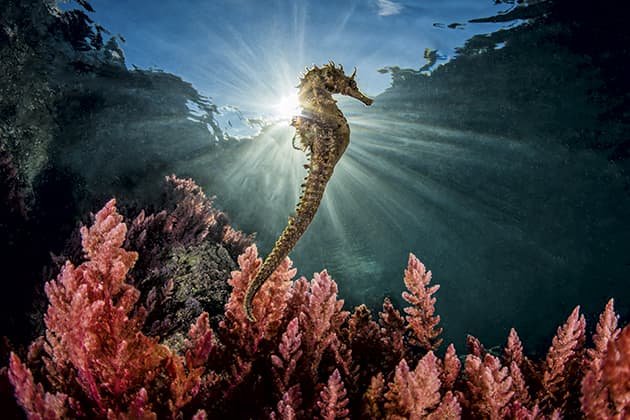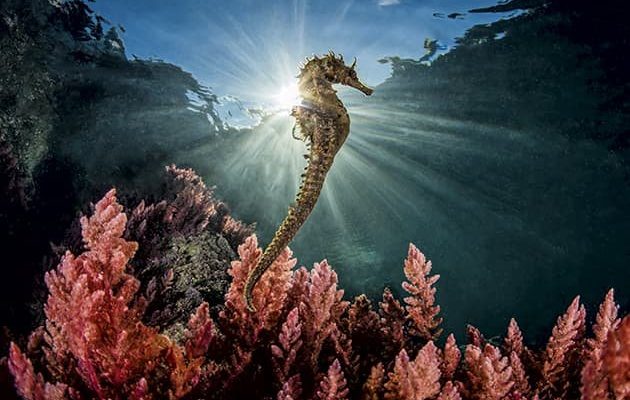
Seahorses are a type of fish, but they don’t swim like other fish. Instead, they use their dorsal fins to propel themselves while using their curly tails to anchor onto seagrass or coral. This unique way of moving slows them down, which is a necessity in a world where currents can be strong and predators lurk nearby. In this article, we’ll explore several adaptations that help seahorses thrive underwater—from their camouflage abilities to their unusual breeding habits.
Camouflage: Nature’s Disguise
One of the most striking features of seahorses is their incredible ability to blend into their surroundings. Think of a magician who can disappear in plain sight; that’s what seahorses do. Their skin has the remarkable ability to change color, allowing them to match the hues of corals, seagrass, and other marine plants. This camouflage is essential for avoiding predators like larger fish and birds.
In addition to changing colors, seahorses have flattened bodies that help them flatten against surfaces. Imagine trying to hide behind a tree; if you flatten yourself against it, you’re much less likely to be seen. By doing this, they become almost invisible in their underwater environment.
This adaptation doesn’t just protect them from being eaten; it also allows them to ambush their prey. When they blend in, they can quietly approach small crustaceans without frightening them away. Camouflage is a crucial survival skill for seahorses, making it a vital part of their underwater toolkit.
Tail Grip: A Handy Anchor
Another fascinating adaptation is the seahorse’s prehensile tail. Instead of using fins to navigate through the water at high speeds, seahorses rely on their unique tails to grip onto plants and other surfaces. Picture a monkey using its tail to swing from branch to branch; seahorses do something similar with their tails.
This ability allows them to stay stable during strong currents and to avoid being swept away. When you see a seahorse firmly anchored to a piece of coral, it’s not just lounging around. It’s also conserving energy! By holding onto something, they can rest while keeping safe from predators.
When hunting, a seahorse can let go of its anchor and use its dorsal fin to swim slowly toward prey. It’s a clever strategy that maximizes their chances of catching a meal while minimizing energy expenditure.
Unique Mouth Structure: Straw-Like Feeding
Seahorses have a distinctive mouth that looks somewhat like a straw. This adaptation serves a very specific purpose: it helps them suck in tiny prey like shrimp and plankton. Instead of snapping at their food, they slowly hover near it and then suck it in quickly, almost like sipping a drink through a straw.
This feeding method is particularly effective in their shallow, weedy habitats. These areas are often rich with small aquatic life, which means there’s plenty to eat. However, because they don’t have teeth, seahorses can’t chew, so they must eat small food items that they can swallow whole. It’s a perfect fit for their slow and steady lifestyle.
Interestingly, due to their unique feeding style, seahorses must consume food almost constantly. They have a high metabolism, so they eat frequently to keep their energy levels up. You might say they have a “sip and go” style of dining!
Reproductive Role Reversal: Male Pregnancy
One of the most intriguing aspects of seahorse life is their reproductive strategy. Unlike most animals, it’s the males that carry the young. Male seahorses have a special pouch on their abdomen where females deposit their eggs during mating. It’s like a built-in nursery for the babies!
After the eggs are deposited, the male fertilizes them and carries them in his pouch until they’re ready to hatch. This adaptation not only protects the developing young from predators but also allows the female to produce more eggs while the male is busy carrying the last batch. It’s a unique partnership that ensures the continuation of their species.
This role reversal in pregnancy is fascinating and often leaves people wondering about the dynamics of their relationships. Seahorse couples often engage in elaborate courtship dances, strengthening their bond before the female deposits her eggs. It’s a heartwarming aspect of their life under the sea.
Body Structure: A Defense Mechanism
Seahorses have a very distinctive body structure that makes them quite different from other fish. Instead of a traditional streamlined shape, a seahorse’s body is covered in bony armor plates that can help deter predators. This structure is like wearing a suit of armor—it’s not flexible but provides excellent protection.
Additionally, their unique shape makes it harder for predators to identify them as prey. The upright posture of seahorses, combined with their ability to blend in, gives them a better chance at survival. Plus, their slow movement means they often go unnoticed by larger, hungry fish.
This adaptation may also help them survive in environments where other fish might panic and flee. Seahorses take their time, carefully choosing when to move and when to stay still. You could say they have a “slow and steady wins the race” mentality.
Seahorses are fascinating creatures with a wide array of adaptations that help them thrive in their underwater world. From their incredible camouflage and prehensile tails to their unique reproductive strategies, every feature serves a purpose in their survival.
By understanding how these adaptations work, we can appreciate the seahorse’s ingenuity in navigating a world filled with challenges. The next time you spot a seahorse, take a moment to marvel at these tiny marvels of nature and how they’ve carved out their niche in the seas. They truly remind us of the beauty and complexity of life under the waves.

